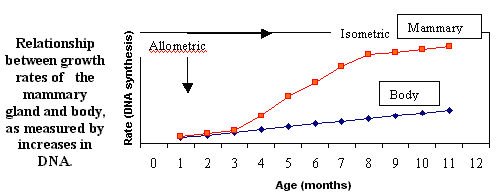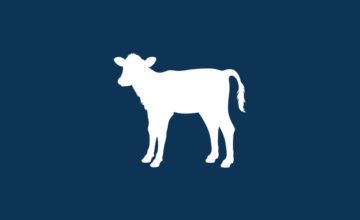Heifer Mammary Development
- Mar 31, 2009
- By Grober Nutrition
- In Canada, USA
It is important to remember that the foundations of udder development are completed within the first 15 months of life. Mammary growth and development is a component of the reproductive process and is affected by hormonal changes that occur as the animal develops. The basic structures of the mammary gland (teats, circulatory system, mammary fat pad and ligaments) are established at birth. From birth to approximately 3 months, the mammary gland grows at roughly the same rate as the rest of the body (isometric growth). During this period, the adipose tissue and the circulatory system develops, which serve as a structure in which the duct network will later develop.
From 3 months until approximately 10 months of age, the mammary gland develops at a faster rate than the body (allometric), contributes a large portion of the ductwork development and increases the size of the fat pad. From 10 months to calving, the mammary growth slows to a rate more consistent with body growth. A large amount (80%) of mammary growth occurs during gestation with most of the milk secretory tissue development occurring during the last 60 days of gestation. The allometric growth is in response to changes in the level and frequency of hormonal secretions associated with puberty, pregnancy and parturition. Proper rate of body weight gain from 3 to 10 months of age may be critical for optimum development of the mammary system. The diet can be influential during this period and incorrect feeding during this period has consequences for the milk production potential of the cow. The heifer’s growth rate is required such that she achieves her correct breeding weight at 15 months but is not allowed to get fat. Puberty is associated with weight and not age. 
The requirement for a high-energy diet, to achieve the target growth rate of high genetic merit heifers, must be balanced with sufficient protein, and in particular, high quality by-pass protein. If the growth pattern is one of high energy alone, fat rather than milk-secreting tissue will be deposited in the udder. This results in a heifer with sub-optimal milk quality and quantity performance. High-energy diets depress somatotrophin (ST) secretion, thus reducing the extent of mammary development. ST (and oestrogen) mediates mammary duct growth.
Grober Nutrition
Recent Posts
Tags
Archives
- October 2024
- July 2024
- May 2024
- April 2024
- January 2024
- December 2023
- October 2023
- September 2023
- August 2023
- June 2023
- December 2022
- November 2022
- October 2022
- August 2022
- July 2022
- June 2022
- May 2022
- April 2022
- March 2022
- February 2022
- January 2022
- August 2021
- February 2021
- September 2020
- June 2020
- April 2020
- May 2017
- April 2017
- October 2016
- September 2016
- August 2016
- March 2016
- March 2015
- January 2015
- December 2014
- December 2013
- September 2013
- May 2013
- January 2013
- December 2012
- November 2012
- March 2012
- March 2011
- February 2011
- November 2010
- August 2010
- December 2009
- November 2009
- March 2009















